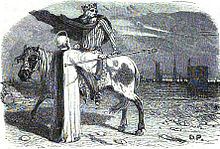
Ys, also spelled Is or Kêr-Is in Breton, and Ville d'Ys in French, is a mythical city on the coast of Brittany that was swallowed up by the ocean. Most versions of the legend place the city in the Baie de Douarnenez.

Quimper is a commune and prefecture of the Finistère department of Brittany in northwestern France.

Cornouaille is a historical region on the west coast of Brittany in West France. The name is cognate with Cornwall in neighbouring Great Britain. This can be explained by the settlement of Cornouaille by migrant princes from Cornwall who created an independent principality founded by Rivelen Mor Marthou, and the founding of the Bishopric of Cornouaille by ancient saints from Cornwall. Celtic Britons and the settlers in Brittany spoke a common language, which later evolved into Breton, Welsh and Cornish.
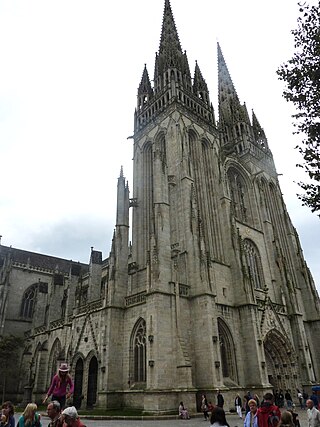
The Diocese of Quimper (–Cornouaille) and Léon is a Latin Church ecclesiastical territory or diocese of the Catholic Church in France. In 1853, the name was changed from the Diocese of Quimper (–Cornouaille) to the Diocese of Quimper (–Cornouaille) and Léon.

Dahut, also called Ahes, is a princess in Breton legend and literature, associated with the legend of the drowned city of Ys.

Gradlon the Great was a semi-legendary 5th century "king" of Cornouaille who became the hero of many Breton folk stories. The most famous of these legends is the story of the sunken city of Ys. He is supposed to have been the son of Conan Meriadoc.
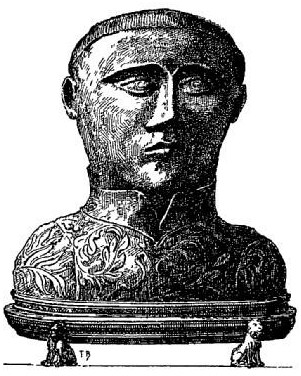
Winwaloe was the founder and first abbot of Landévennec Abbey, also known as the Monastery of Winwaloe. It was just south of Brest in Brittany, now part of France.

Quimper Cathedral, formally the Cathedral of Saint Corentin, is a Roman Catholic cathedral and national monument of Brittany in France. It is located in the town of Quimper and is the seat of the Diocese of Quimper and Léon. Saint Corentin was its first bishop.

Melor was a 10th-century Breton saint who, in England, was venerated in Cornwall and at Amesbury Abbey, Wiltshire, which claimed some of his relics.
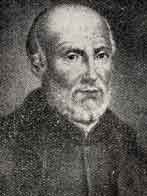
Julien Maunoir, was a French-born Jesuit priest known as the "Apostle of Brittany". He was beatified in 1951 by Pope Pius XII and is commemorated by the Catholic Church on 29 January and 2 July.
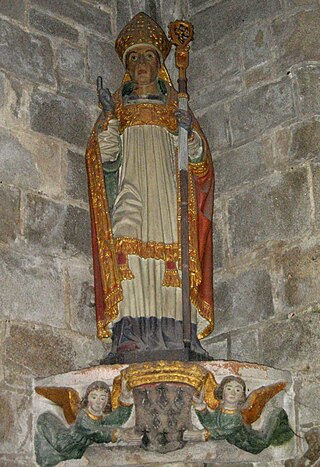
Saint Ronan was an Irish pilgrim saint and hermit in western Brittany. He was a son of Saint Berach and the eponymous founder of Locronan and co-patron of Quimper (France), together with its founder, Saint Corentin.

Poher is an ancient principality that emerged in the Early Middle Ages in Cornouaille in west-central Brittany. Its capital was the Gallo-Roman city of Vorgium, capital of the Osismii, which became Carhaix after the fall of the Roman Empire. Archaeological excavations scheduled since 1999 show that, even if the city lost its function as capital after the 4th century, it was nonetheless a stronghold and major strategic crossroads.
François Bazin was born in Paris on 31 October 1897 and died in Paris in 1956. His parents were engravers and medalists. Early years were spent in Chile where his parents taught at the Santiago art college. The family returned to Paris in 1913 and Bazin enrolled at the Paris École des Beaux-Art. He was mobilized in 1916 and attached to a squadron whose planes were equipped with Hispano Suiza engines. After the war he completed his studies and was runner-up for the Prix de Rome in 1925. Although not a Breton many of his works can be seen in Brittany including "The monument aux bigoudens", the monument at the Pointe de Pen Hir and the "Filles de la mer" statue at Quimper.

The Argol Parish close, including the Église Saint-Pierre et Saint-Paul, is located in Argol in the arrondissement of Châteaulin in Finistère in Brittany in north-western France. The parish church of Saint Peter and Saint Paul was built in 1575, restored in 1617 and enlarged in 1674. In 1784, the side walls were completely reconstructed as was the porch in 1839. The lintel of the belfry on the west gable of the church records the date 1582, Both the church and the "arc de triomphe" were listed as historical monument in 1914.. The church is also associated with Saint Geneviève who was nominated as the secondary patron in 1634. Records show that there was a priory run from the Benedictine abbey at Landévennec in the Middle Ages.

Saint Goulven de Léon was a saint in Brittany in the 6th-7th century. Any knowledge of his life is derived from his vita, of which only a copy of a transcription of the original remains and whose historical accuracy is in question. According to that vita, he was the bishop of Saint-Pol-de-Léon in the seventh century, after having acquired a reputation as an ascetic and anchorite whose prayer and presence cured people and had helped fight off a Viking invasion. When he was elected as bishop, he tried to avoid that responsibility by going to Rome; after intervention by Pope Gregory I he returned and served for over a decade. He died in Rennes, where he was buried in the cathedral. He continued to be venerated in various parts of Brittany, most notably in the small commune of Goulven and other communes nearby in the Pays de Léon, the very western part of Finistère.
Cornouaille may refer to:
Morvarc'h is the name of a fabulous horse of Breton legend found in two folktales reworked in the 19th and 20th centuries. Though its name appears in older sources, it was invented or reinterpreted by Charles Guyot, who named it Morvark in his version of the legend of the city of Ys in 1926. It belongs to the "Queen of the North" Malgven, who gives it to her husband King Gradlon. Endowed with the ability to gallop on the waves, Morvarc'h is described as having a black coat and as breathing flames through its nostrils. It also appears in a Breton folktale about King Marc'h of Cornouaille. In the course of a deer hunt it is killed by its own rider's arrow, which has been turned around by the spell of Dahud, the daughter of Malgven. She then puts the ears of the horse Morvarc'h on the head of King Marc'h, who seeks in vain to hide them.
Malgven, or Malgwen(n), is a character introduced into the legend of the city of Ys, a mythical city on the coast of Brittany, at the end of the 19th century by Édouard Schuré, and is possibly based on a local legend from the Cap Sizun. She was made known by Charles Guyot (Géo-Charles) at the beginning of the 20th century, in his literary adaptation of the legend of Ys. As a valkyrie and queen of the "North", Malgven reigns over the land with her ageing husband, King Harold. She meets King Gradlon while he is raiding and falls in love with him. She persuades him to kill her husband and to flee with her on her horse Morvarc'h, towards Gradlon's lands in Brittany. The journey lasts a year, during which time she gives birth to a daughter, Dahut. Malgven dies in childbirth.

